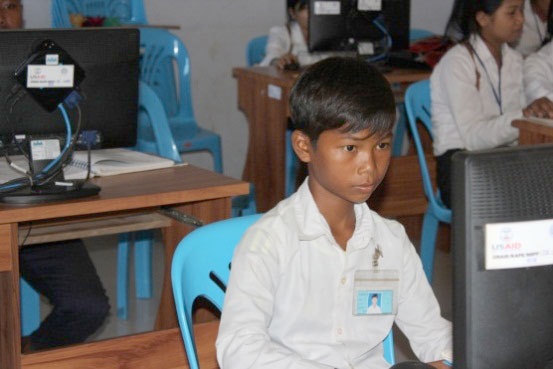[vc_row][largura da coluna_vc=”1/1″][vc_column_text]
Computer courses keep Cambodian students in school
Por Jennifer Brookland
[/vc_column_text][/vc_coluna][/vc_row][vc_row][largura da coluna_vc=”2/3″][vc_column_text]

Ry Phanith is the smallest student in his ninth grade class at Bay Damram School in northwestern Cambodia—so short he has trouble reaching the pedals on his bike as struggles along rural roads each morning to get to class.
The trip is just one of the challenges he faces in trying to stay and succeed in school. The oldest son of farmer parents, Phanith was often pulled out of class to help on the farms where his family grows corn, beans and sugarcane. The combination of frequent absenteeism and poor performance in key courses like Khmer language and physics put the 15 year-old in danger of dropping out.
He would not have been alone. About one in five lower primary students in Cambodia never make it to high school, leaving them unskilled and reducing their chances for employment.
To keep students in school, USAID’s School Dropout Prevention Pilot (SDPP)—implemented by Creative Associates and local partner Kampuchean Action for Primary Education–is working with 215 schools across six provinces of Cambodia on dropout mitigation. The program’s Early Warning System identifies students like Phanith who need extra support from teachers and parents to stay in school.
To provide engaging skills-based enrichment activities attractive to both students and parents, SDPP also supplied Bay Damram School with a computer lab where students follow the Ministry of Education’s computer literacy curriculum for two-hour each week.
“Both interventions have reduced the dropout rate in my school in this academic year,” says Tak Chankoy, Bay Damram’s Director. “SDPP is not only providing my students with a special life skill (computer literacy), but the program is also following up with at-risk students on attendance, behavior and course performance.” These three critical behaviors—the “ABCs” of dropout–are considered the best predictors of student dropout worldwide.
No 2011-2012 ano letivo, Bay Damram had a 27.3 percent dropout rate—higher than the regional average of nearly 23 percent for lower secondary school. After it received the early warning system and computer lab, the school reports the 2012-2013 dropout rate fell to 16.8 por cento. Preliminary results will be confirmed through the rigorous randomized control trials SDPP is conducting in 322 treatment and control schools.
Phanith has no intention of leaving now, especially when he enjoys computer training so much. “I’m enthusiastic to learn the computer because being knowledgeable in computer skills is vital for my future study and career,”ele diz. Although he hopes to one day become a teacher, for now he especially enjoys typing and laying out articles and photos for newspapers and magazines.
When they saw the value of computer knowledge, Phanith’s parents even bought a secondhand computer so he can practice at home. They remind him to study hard in school so he won’t have to be a farmer for the rest of his life.
He is following their advice: Phanith has rarely been absent from school since the computer lab was installed. This year he will take the national exam that caps nine years of basic education—a notable success for children in this region.
“Phanith is one of the most active students in my computer class,” says instructor Meas Chanbopha, who says he always finishes exercises first and asks for help to make sure he is mastering the lessons. “Because of computer class, I believe Phanith will continue to study to achieve his goal.”
SDPP is also being piloted in primary and secondary schools in India, Tajikistan and Timor Leste.
Reporting was contributed by Buntha Thol.[/vc_column_text][/vc_coluna][largura da coluna_vc=”1/12″][/vc_coluna][largura da coluna_vc=”1/4″][vc_widget_sidebar barra lateral_id=”barra lateral primária”][/vc_coluna][/vc_row]